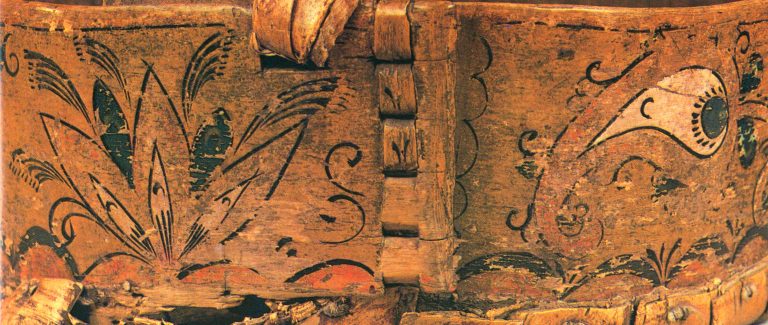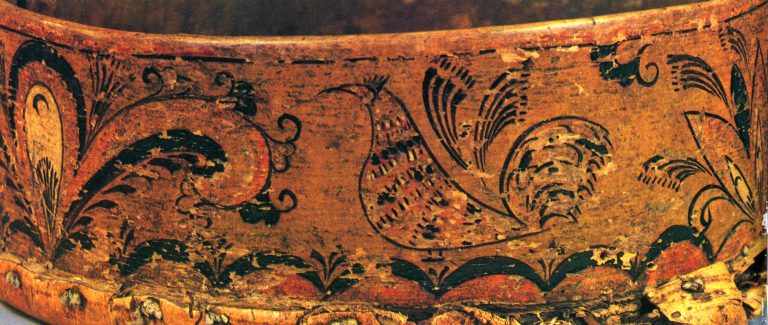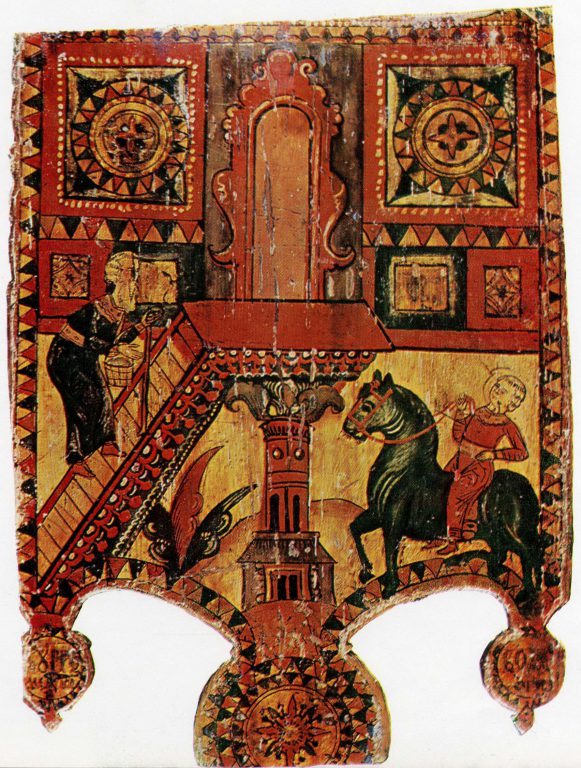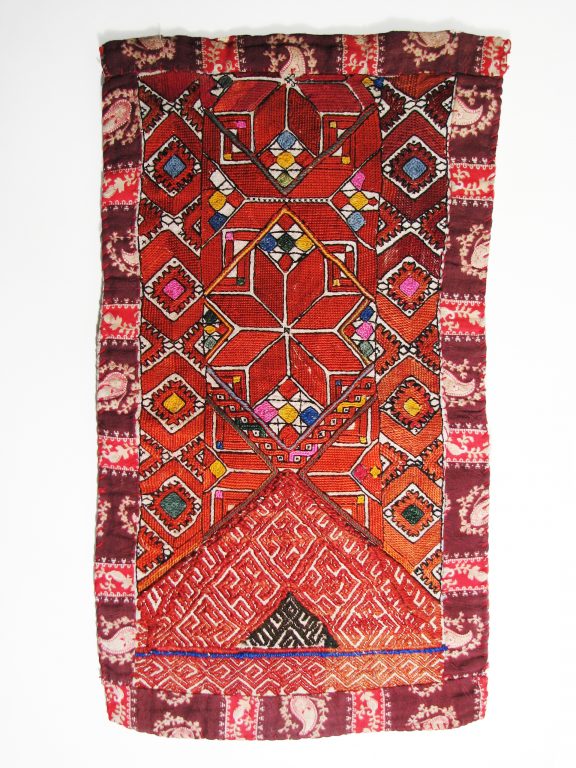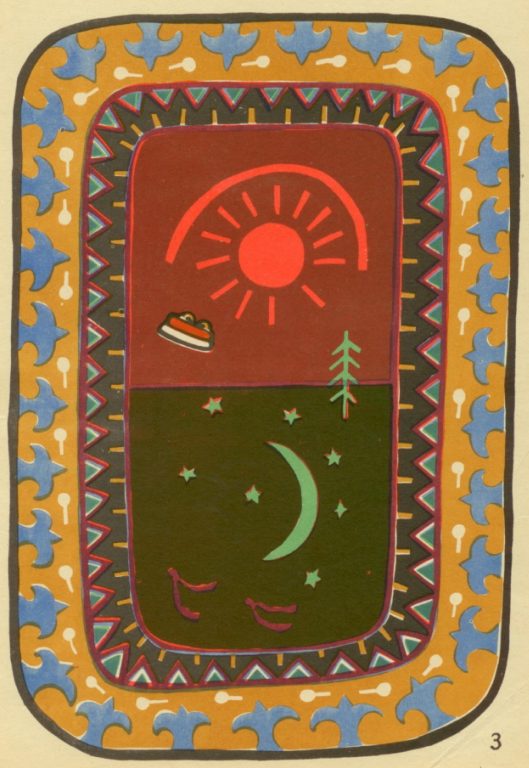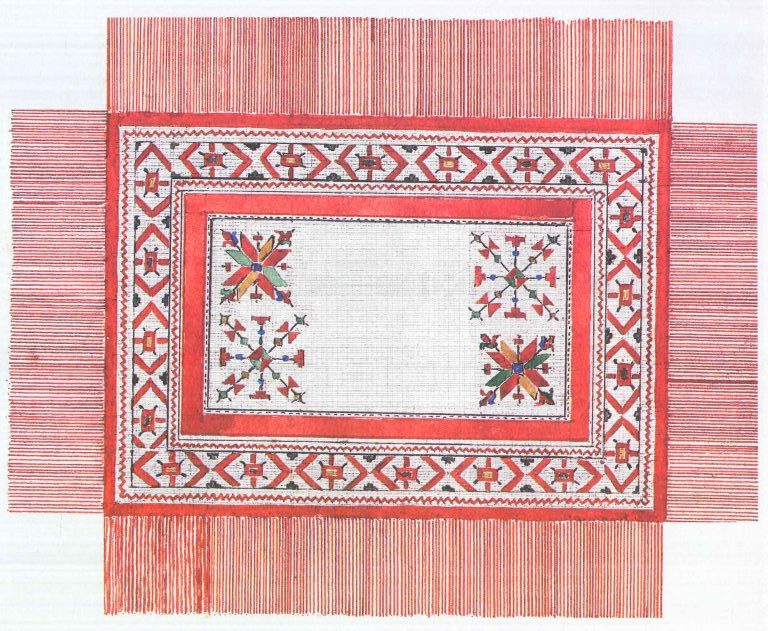THE LUSH BUSH OF NORTHERN PAINTINGS
The Northern Dvina is a navigable river. From the mid-16th to the early 18th cc., it was the largest transport corridor linking Russia and Western European countries. Towns and villages located near the river were important centres of trade, crafts, and folk arts.

Permogorye, Rakulka, Nizhnyaya Toyma, Puchuga, Borok are large settlements -‘bushes’ that unite several villages. They were founded by people who migrated from Veliky Novgorod and Moscow to the Dvina region in the 12th-15th cc. They were old believers and free peasants – gifted, enterprising, and usually literate people.
Centres of traditional peasant painting on wood emerged there, on the shores of the Northern Dvina, in the late 18th – early 19th cc. Prominent examples include Permogorye, Rakulka, and Borok techniques. Making their goods, local craftsmen would implement motifs of ancient Russian monumental paintings, icons, and book miniatures.
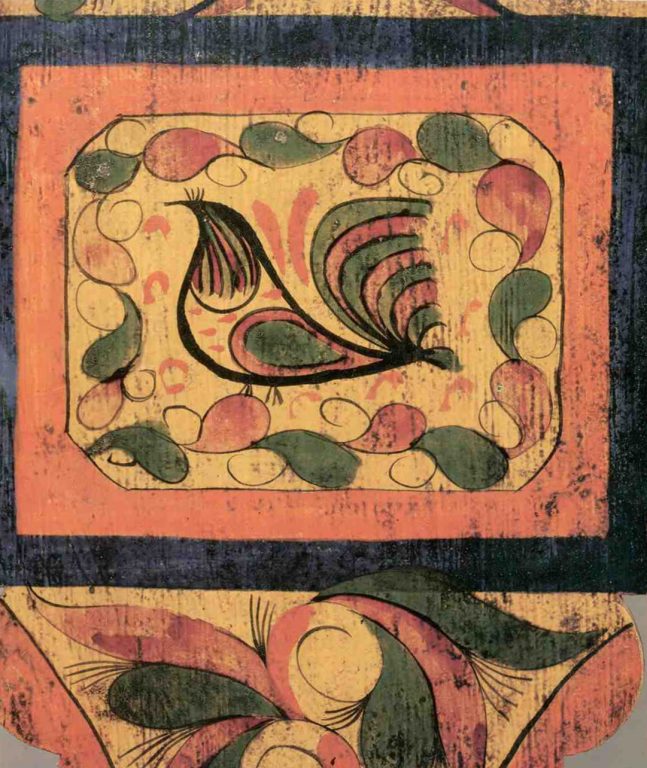
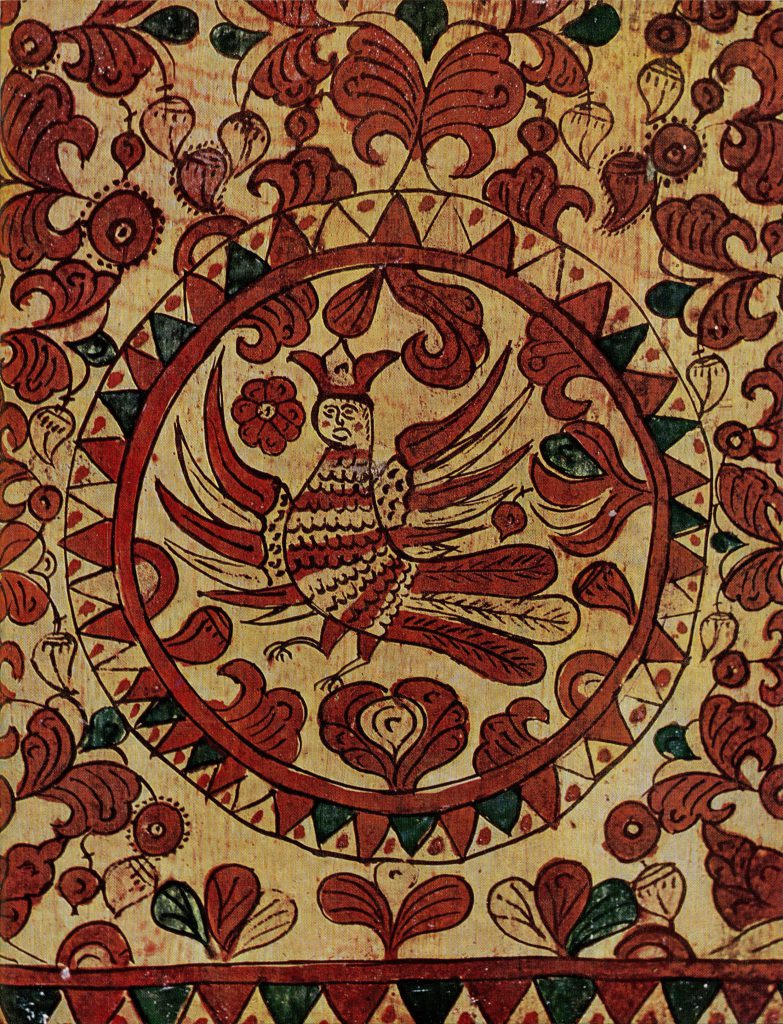

With this article about Rakulka painting, we start the series of materials dedicated to patterns in the Northern Dvina folk art.
HOW RAKULKA PAINTING WAS DISCOVERED AND WHAT WE KNOW ABOUT RAKULKA CRAFTSMEN
As a distinctive type of painting, the Rakulka peasant style was first explored and described by Olga Kruglova in 1959. She was a member of an expedition to Arkhangelsk Oblast’ organised by the Zagorsk State Museum-Rreserve of History and Art. The style was named after a small river called Rakulka.
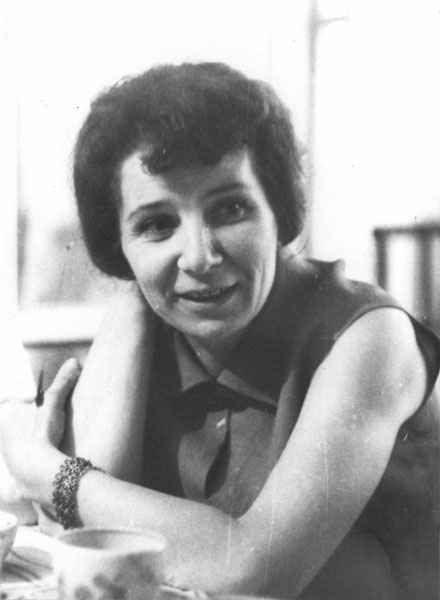
In the 19th century, painting on wood was a family enterprise. Secrets of this craft were transmitted from one generation to another. In villages of the Nothern Dvina region, it was the Vityazev family who made painted wooden artefacts. They ran the enterprise from the mid-19th century to the 1930s. Olga Kruglova distinguished six artisans who belonged to this family.
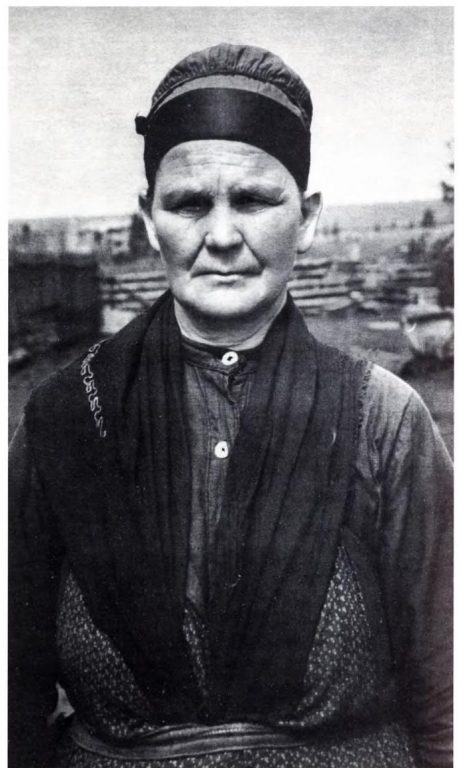
Source: Kruglova O. V., Folk Painting of the Northern Dvina (in Russian). Moscow: Izobrazitelnoye Iskusstvo, 1987. P. 26.
The Vityazevs were the only family who made Rakulka painting. This fact allowed Olga Kruglova to presuppose that it was a dynasty of old believers, “who fled persecution and had to move to… a safer place, where the family started to produce painted items instead of copying and decorating books.”
Peculiarities of Rakulka Painting
The Rakulka style is a distinctive type of painting, since it differs from other related styles in its ornamentation – it contains only floral motifs and birds. Art historians claim that Rakulka painting has a particular graphic style and a peculiar composition.
5 Characteristic Features of Rakulka Painting:
- Floral patterns are the basic element of this type of painting. They include bushes, tulips, and shoots with big tear-shaped leaves.
- 1. Birds in Rakulka painting have big rounded bellies, small heads with crests, and tiny legs. Few paintings also contain images of hairy dogs.
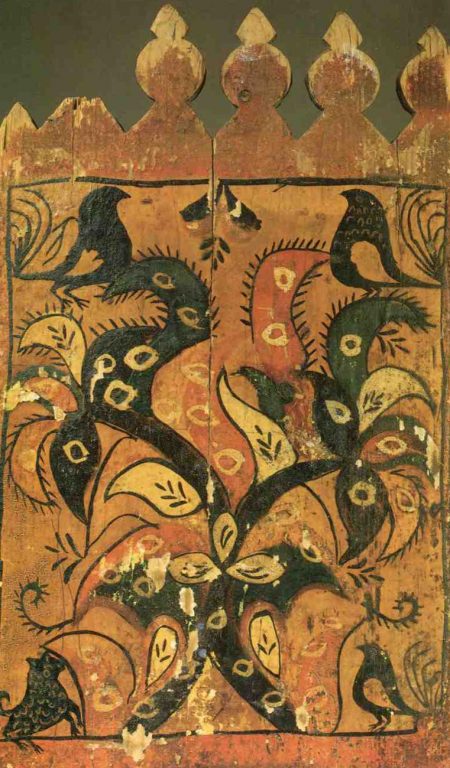
- The composition of Rakulka painting is very dynamic. This is achieved with the help of thin swirls, tendrils, and streaks coloured black. Additional figures in the shape of semicircles (so-called ozhivka) are painted white. Such elements are absent in late paintings though.
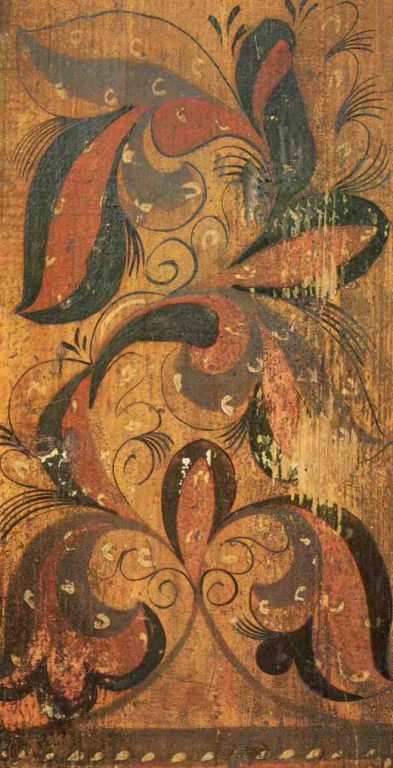
- The colour scheme of Rakulka painting is based on three hues: golden buff, deep green, and red. Sometimes there can also appear shades of blue.
- 5. The background of painting is always yellow.
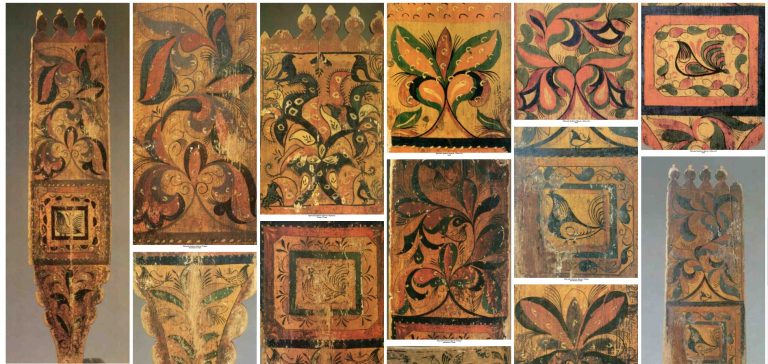
If you would like to access these objects, check the links in the end of the article
The Decoration of Baskets and Distaffs
Small baskets for berry picking are called nabirukha. A nabirukha below was decorated by gifted artisan Dmitry Vityazev. Its ornamentation includes big flowers and birds and covers the whole surface of the basket. Various black streaks, tendrils, and spiral swirls add extra dynamics to this composition. Such details are another characteristic feature of Rakulka painting. They look like colourful splashes that highlight the rhythm of different parts of the pattern.
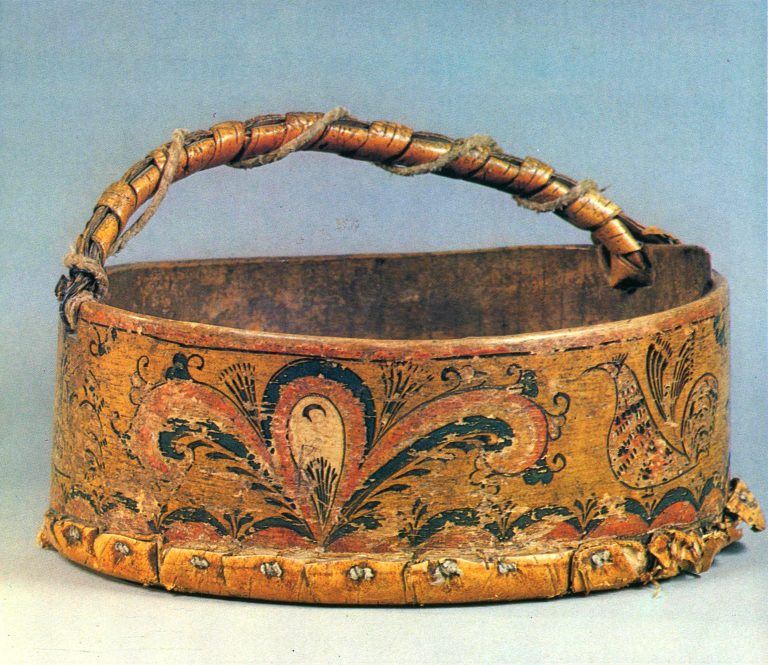
Distaffs used to produce yarn were the most common items adorned with Rakulka painting. Each region had its own type of distaff: they differed in their shape, size, and decoration. Distaffs were carved from tree trunks with roots. The lower part of a trunk was used to make an upright blade and a “foot,” while horizontal offshoots of the root served as a material for a base (a seat). A typical Rakulka distaff has a long and thin upright blade that tapers towards its bottom part and forms a distaff’s foot adorned with three semicircular figures to its left and to its right.
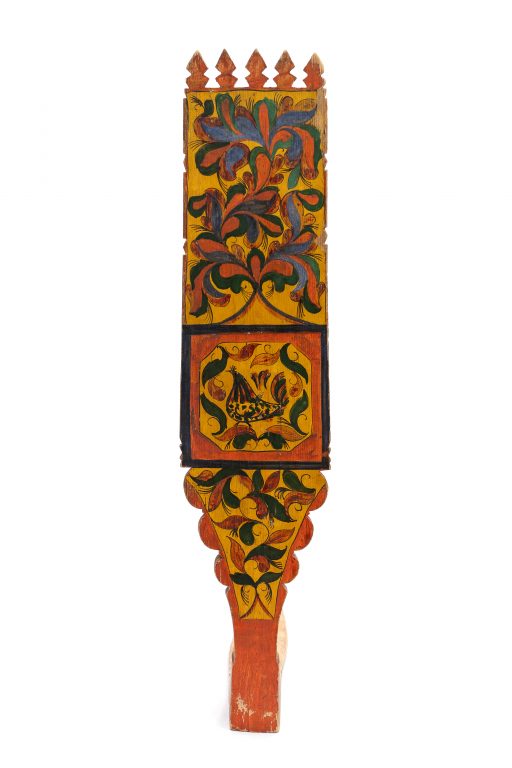
From the collection of the Sakhalin Regional Art Museum
The frontal side of the distaff can be divided into three parts (vertically). A large, S-shaped shoot (tree branch) with rounded tear-shaped leaves decorates the upright blade. It “grows” from a triangular hill depicted below. Black tendrils decorate gaps between the leaves.

From the collection of the Sakhalin Regional Art Museum
The lower part of the blade contains a framed image of a tubby, crested bird in leaves. Curved red and green lines comprise the bird’s large tail. Various dots and streaks on the bird’s body stand for feathers. Small feet are sketched with thin strokes.
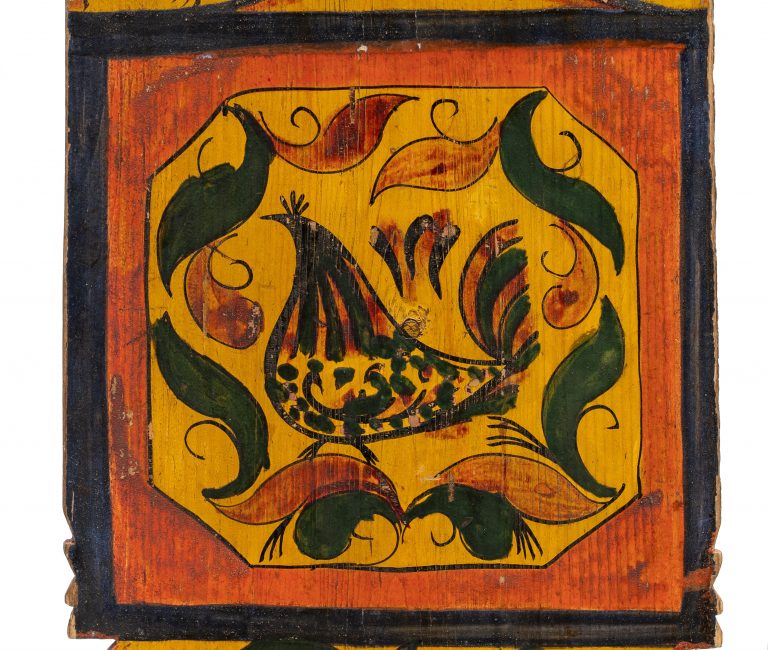
From the collection of the Sakhalin Regional Art Museum
Traditionally, the extension of the distaff’s foot under the upright blade is also adorned with leaved offshoots. Sometimes feet are decorated with tulips or small birds.

From the collection of the Sakhalin Regional Art Museum
The Technique of Rakulka Painting
The undercoat for painting was made from materials traditional for Russian icons. They included fish glue, chalk, sometimes white lead or white clay (for density) without any colourants or pigments. Artisans painted on white background. To make paints, they used not only local pigments (ochre, soot, et cetera), but also imported ingredients (ultramarine, malachite). White clay served as a whitewash.
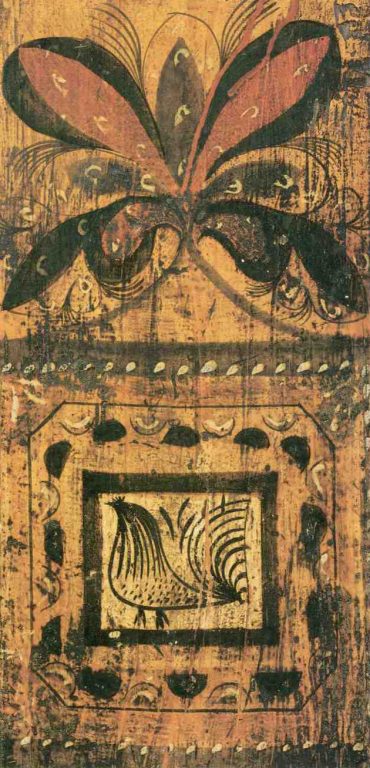
To protect the coat of paint, artisans covered items with special varnish made from flour glue and yolk. Such a covering can tolerate dampness, cold water, and physical impact and has a shiny glassy surface. Moreover, this varnish was of a particular yellow shade (because of yolk). It was what added to the overall composition of Rakulka painting instead of coloured undercoat (as was believed earlier). So Rakulka painting obtained its characteristic yellow background only on the final stage of the painting process, after varnishing.
In the 1930s – the last decade of the existence of Rakulka painting – it was problematic to get paints. That is why some artisans substituted green pigments with ochre and stopped using white colours. The well-balanced colour scheme of Rakulka painting was also negatively impacted by the spread of artificial aniline dyes, which made background too bright. However, the overall manner and traditional composition of Rakulka painting were preserved even in late examples of this style.
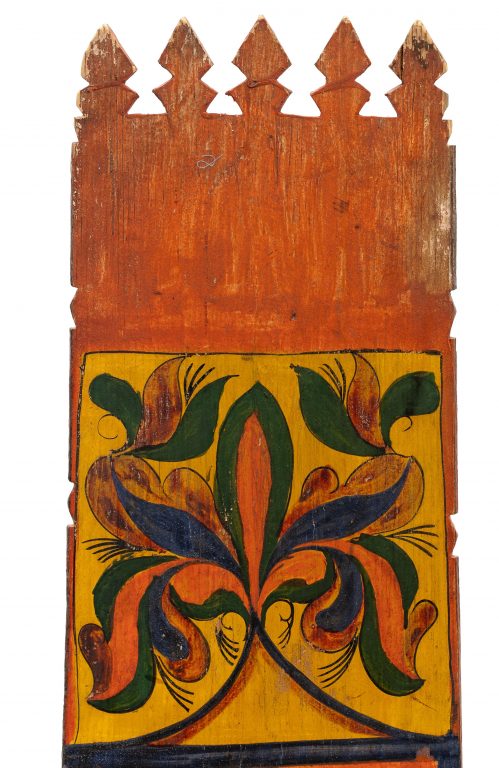
From the collection of the Sakhalin Regional Art Museum.
Where Can You See Items Decorated with Rakulka Painting?
Items with Rakulka painting can be found in collections of many Russian museums. Selected examples include:
- The State Museum Association “Art Culture of the Russian North” (Arkhangelsk),
- The State Open-Air Museum of History, Architecture, and Ethnography “Kizhi” (Kizhi Island, the Republic of Karelia),
- The Russian Museum of Ethnography (Saint Petersburg),
- The State Russian Museum (Saint Petersburg),
- The All-Russian Decorative Art Museum (Moscow),
- The Sakhalin Regional Art Museum (Yuzhno-Sakhalinsk),
- The Sergiyev Posad State Museum-Rreserve of History and Art (Sergiyev Posad),
- The Smolensk State Museum-Preserve.
Workers of the Sakhalin Regional Art Museum responded to our request to share photos of items with Rakulka painting. Senior Researcher of the museum Evgeniya Vorozhtsova sent us photos and a description of a distaff from their collection. Just think how long the journey of this distaff from the Northern Dvina to Sakhalin was! Such items have a special value, as they allow people from the Far East to explore folk arts from the western part of Russia. They unite Russians from different regions through material culture.
We would like to thank Evgeniya Vorozhtsova for helping us prepare this article and providing the detailed description of the distaff with Rakulka painting from the collection of the Sakhalin Regional Art Museum.
Editor of this article: Elizaveta Berezina.
Works cited:
- Alekseeva O. V. Rakulka Painting. New Materials (in Russian) // Ryabinskiye Chteniya – 2007. Ed. by T. G. Ivanova. Petrozavodsk: Museum-Reserve “Kizhi,” 2007.
- Bernshtam T. A. Peasant Domestic Painting of the North and Povolzhye: 18th-19th cc. (in Russian) // The Collection of the European Section: Exhibition Projects. Catalogues. Research: Collection of articles (in Russian) / ed. by T. A. Bernshtam, A. I. Teryukov. Saint Petersburg: Nauka Publishing House, 2008. Pp. 144-202.
- The State Russian Museum Presents: Russian Distaffs (in Russian). Almanac. Vol. 7. / text by N. Taranovskaya. Saint Petersburg: Ra, 2001.
- Zinovyeva T. B. Rakulka Painting. Folk Painting of the Northern Dvina (in Russian). Moscow: “Skazochnaya Doroga” Publishing House, 2015.
- Kruglova O. V., Folk Painting of the Northern Dvina (in Russian). Moscow: Izobrazitelnoye Iskusstvo, 1987.
- Pandina L. V. Rakulka Painting (in Russian). Arkhangelsk: Arkhangelsk Regional University for Retraining and Skills Development of Education Workers, 1995.













